By 2060, Japan is expected to have a population of 86.7 million, down from the peak of 128 million in 2008. At least 40% of the 86.7 million is expected to be 65 or older. As the population declines, there will be fewer young people to care for the older. Tokyo is expected to have medical and nursing shortages (Future, 2015). The decline in Japan’s population has been in the works since at least the 1970s. Why has Japan become a society without children? Has Japan become a sexless society?
The Childless Society
Japan remains a culture that equates marriage with children: only 2.3% of children were born out of wedlock in 2014 (Masangkay, 2017). So we have to look at the state of marriage and relationships in order to understand the population decline.
It’s no secret that Japanese people, like Americans, are marrying less often and later in life. The trend has been long. In 2008, Patricia Boling looked at the mechanisms behind Japan’s declining birthrate and hit on various reasons that remain in play 10 years later. Since the 1990s, the Japanese government has tried to encourage couples to have more children by implementing parental leave options and reforming the tax code. When Boling wrote her article, Japanese tax code granted working men tax credits as long as their wives didn’t earn above a certain amount in a year. In the past, the tax code even allowed for a special payment called the “special dependent spouse payment.” Although this had been eliminated in 2004, Boling’s example shows how the cultural ideas of the Edo period and even further in history hang on.
Throughout Japanese history, the house, the ie, demanded the focus of men and women. Men focused on the external aspects of the house–income, social sphere, politics, and honor–while women focused on the internal–managing the finances, rising children, marriage, and the family’s honor. The idea continues to exist in modern Japan. As Boling discovered in her interviews, mothers who took parental leave often found themselves ostracized by their coworkers who had to take up the slack. Those coworkers believed taking leave to have a child is a sign of the mother’s lack of devotion to her career. Likewise, returning to work suggested she lacked devotion to her new child. In short, career women found themselves trapped in a modern version of the house system–external honor of the career versus the internal obligation to raise children.
Career-track women, like men, are expected to put in 10-15 hours every day. Women were penalized if they left to pick up their children. These long work hours contribute to many of the issues Japan has as we will see. Women who want to have children feel unprepared for motherhood and often lack the resources to help them learn. Husbands provide little help (Boling, 2008). While many Japanese husbands have become more involved in raising children since Boling wrote her article, the social momentum for tradition still exists. Boling (2008) summarizes all the factors:
Japan’s very low fertility rate clearly appears to be related to the structure of its labor market. As more women attend university and gain access to good jobs, the opportunity costs of career interruptions to stay home with small children increase. Full-time work is difficult to balance with being a primary parent, because of the combination of excessive demands on workers’ time and lack of adequate childcare and parental leaves. In a system that structures work and family-support policies in this way, being a full-time worker and being a mother are incompatible. At the same time, women’s incomes are increasingly indispensable for a middle-class standard of living, making women more reluctant to quit work.
All of these time demands affect the ability of people to find a partner and marry. Women have to choose between work and love in many cases. Men are stuck with long work hours. In fact, men without full-time jobs often feel unsuited to find a girl to marry and start a family with. These men may freelance and bring in a decent income, but they are often without benefits and have to live with their parents. Under Japan’s employment system, their failure to lock in a career early in adulthood makes it harder for them to find a good career later (Vogal, 2012).
The Relating Problem
Aside from work dynamics, Japanese people struggle with relating to others. In a survey of people ages 18-34, 70% of unmarried men and 60% of unmarried women are not in a relationship (Tharoot, 2016). The numbers suggest men and women struggle to associate with each other. They even consider the opposite sex a mystery. Some of this stems from a phenomenon called “K.Y.” (kuuki ga yomenai) which is the inability to read the social atmosphere between people. In Japan, relationships rely on sassuru, the non-verbal sense of another’s feelings or state of mind (Vogal, 2012). However, many young people lack this skill and struggle with relationship problems the older generations did not. This skill combines with Japanese society’s reluctance to reveal a person’s inner world (tatemae) and makes forming friendships and loving relationships difficult. Japan culture’s historical focus on harmony has led to many young people fearing social interaction and rejection. Dropping the polite facade (honne) runs the risk of alienation. After all, who hasn’t felt the fear of rejection or of a cute someone thinking you are a weirdo if they learn who you really are?
Japanese culture has been changing too. Japanese women are becoming increasingly confident and taking control of their careers. They work more than American women work. As Boling wrote in 2008, women’s incomes had become a vital part of the household’s sustainability. And the expansion of women in the workforce over the past 10 years has increased this importance. However, this comes at a social cost. Many Japanese women struggle to find men who are confident about themselves and who are able to reciprocate in a relationship (Vogal, 2012). They look for an equal partner.
Virginity and Sexless Marriages
All of this allows for Japan to have a high rate of virginity and sexless marriages. Surveys find around 42% of men and 44.2% of women admit to being virgins (Tharoot, 2016; McCurry, 2017). Likewise, 50% of married couples admit to not having sex in more than a month (McCurry, 2017). When you look at the graph from 2010 and compare it with the latest data from 2017, you see a long-term trend in sexless marriages. Some of the same factors in the dating world apply here: men and women working too long of hours, lack of communication, and all the factors. Virginity rates will likely climb with the rates of sexless marriages.
More than 22% of women find sex “troublesome” and 35.2% of men report being too tired after work for sex (McCurry, 2017). The highest rates of sexless marriages appear among people in their 40s, the time when the demands of work and family tend to be highest. Those families who do have children will see a drop off in their sex-lives as their couple time decreases. Sexless couples report a fear of intimacy, even a fear of touching each other. Both men and women in sexless marriages lack close friendships, suggesting the issues extend beyond their spouses to social life in general (Vogal, 2012). Women in sexless marriages report a fear of pain, and many men are unable to have erections because of anxiety. Many of these men connect their anxiety with their critical, overprotective mothers (Vogal, 2012).
The inability to connect sits at the core of these issues and all the factors we’ve discussed contributes to this. The United States also suffers from Japan’s trend: only 50% of Americans are married with Asians marrying at higher rates, followed by whites. Hispanics and blacks are least likely to marry, at 46% and 30% respectively (Parker, 2017). Each group reports similar reasons to Japan: not finding the right person yet (inability to connect) and financial reasons (instability, long work hours, etc).
Waifus, Anime, and Sexless Relationships
Many people turn toward the otaku subculture and waifus/husbandos to avoid the risks of three-dimensional relationships (Vogal, 2012). Japan offers many ways to meet pent-up demands for relationships and sex within the anime world. Documentaries often feature hentai stores that also sell sex toys and other forms of auto-eroticism. But we can’t overestimate how otaku culture relates to the relationship problem. Otaku culture mainly works as a reaction, a pressure valve, for people who struggle with all the reasons we’ve discussed. It isn’t a cause. Although it can be for some people. After all, fantasy can be powerful and no man or woman can match fantasy. However, the sexual side of anime culture emerged out of demand for some sort of connection, even if it is with a fictional character. It emerged as an escape from long work hours and social pressures. It provides safe place, free of rejection. But a sense of discomfort might also drive people to learn sassuru and how to connect with others if otaku culture didn’t provide an outlet.
Otaku culture also makes it difficult for people to connect because of the expectations. The messages we consume creates our world view, and reality cannot match fantasy.
Should Japan Solve the “Problem” of a Sexless Society?
I’m not convinced depopulation is a negative event. In the short term, difficulties will arise–lack of nursing care, contracting economies, and similar things. However, in the long term a smaller human population will decrease stress on the ecosystem. We will see fewer exotic diseases appear as we stop encroaching on environments best left untouched. We will see a larger share of resources per person. Likewise, we will see lower CO2 emissions and other waste. Perpetual population increase isn’t healthy. Nature has the habit of checking populations with disease and ecological collapse. I would rather we voluntarily reduce our birthrates than face a mass die off in another Spanish Flu or bubonic plague style event.
I’m also a bit old fashioned so I applaud so many Japanese people remaining virgins. I stand against hook-up culture and the oxymoron casual-sex that pervades many societies. Japanese culture suggests there are other outlets for such impulses–yes, even including the sexual side of anime. We have to remember that most of the virgin population of Japan aren’t consumers of hentai and the like. As we’ve seen, most of them channel their energy into their careers. Quite a few channel the energy to other hobbies aside from anime.
Sexless relationships become a problem when it isn’t a mutual agreement between the people in the relationship. When the underlying roots of the issue–fear of intimacy, lack of communication, and the like–are addressed, sex will have room to naturally happen.
So should Japan solve its sexless problem? I don’t believe it really can. People are choosing not to have sex for their own reasons. While Japanese society–and American society for that matter–needs to address the barriers to forming connections between people, ultimately, it is up to each person to choose what is best for themselves and their relationships.
References
Boling, Patricia (2008) Demography, Culture, and Policy: Understanding Japan’s Low Fertility. Population and Development Review, 34 (2) 307-326.
Future Depopulation in Japan: A Cabinet Committee Report. (2015). Population & Development Review, 41(2), 369–372. https://doi.org/10.1111/j.1728-4457.2015.00061.x
McCurry, Justin (2017) Record numbers of couples living in sexless marriages in Japan, says report: Survey by country’s family planning association found that nearly half of married couples had not had sex for more than a month. The Guardian.
Masangkay, May (2017) Japan’s ‘single mothers by choice’ fight stigma, seek to change perceptions. The Japan Times. https://www.japantimes.co.jp/news/2017/06/07/national/social-issues/japans-single-mothers-choice-fight-stigma-seek-change-perceptions/
Parker, Kim and Stepler, Renee (2017) As U.S. marriage rate hovers at 50%, education gap in marital status widens. Pew Research. http://www.pewresearch.org/fact-tank/2017/09/14/as-u-s-marriage-rate-hovers-at-50-education-gap-in-marital-status-widens/
Tharoor, Ishaan (2016) Japan has a worrying number of virgins, government finds. Washington Post.
Vogal, Suzanne Hall (2012) Japanese Society under Stress. Asian Survey. 52 (4) 687-713.
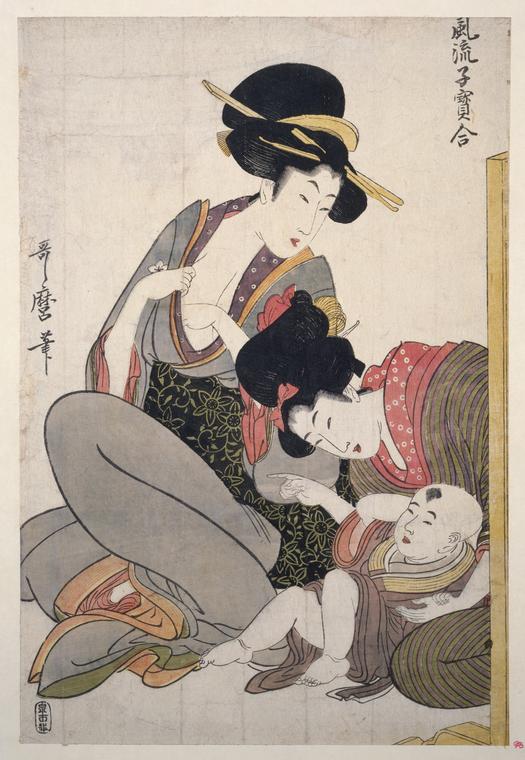


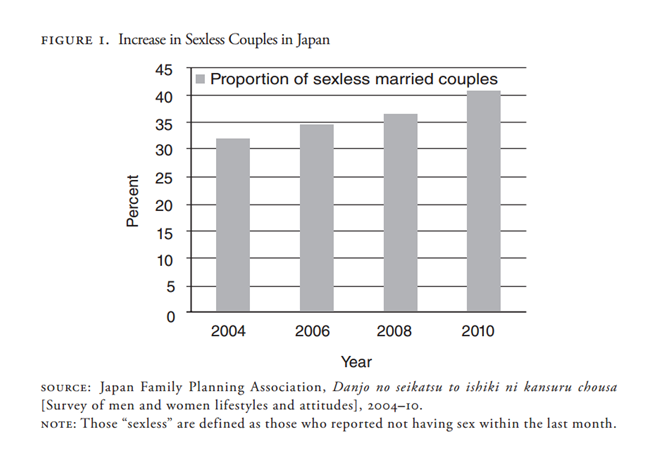
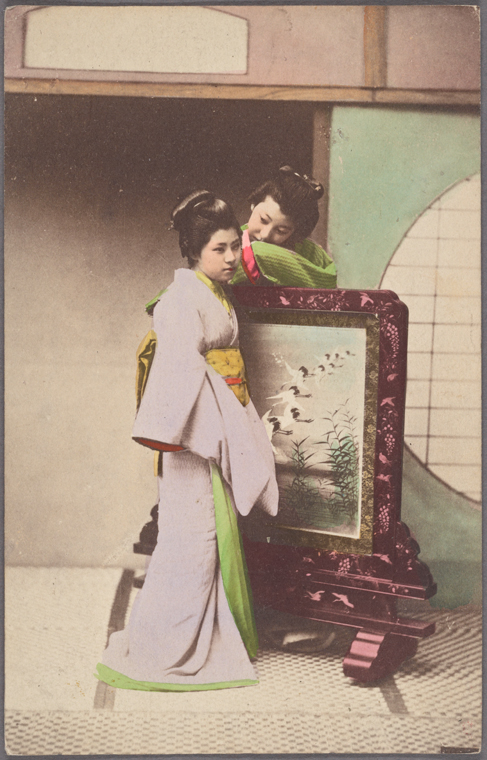


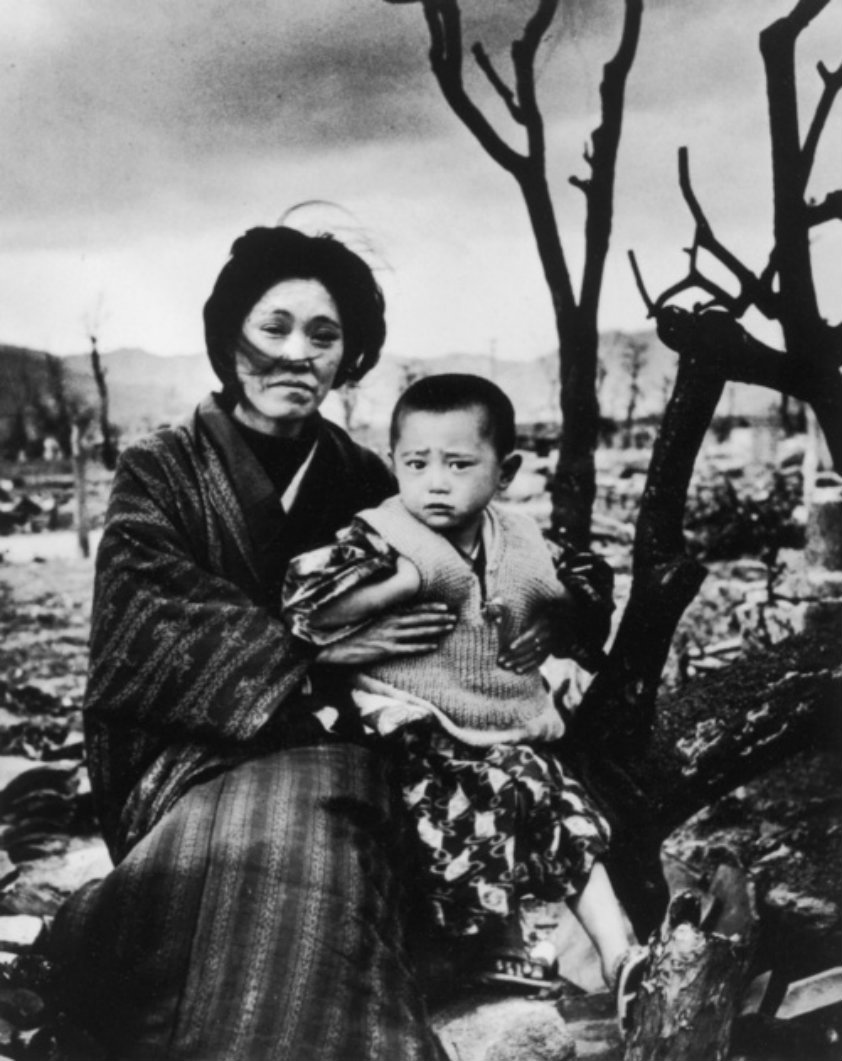


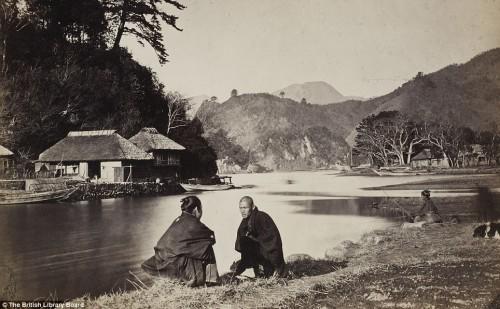
Why is “sexless” used only to explain low fertility in Japan? There are a number of countries with lower fertility rates than Japan including Italy, Spain, and Korea.
Italy appears to have economic reasons as the leading factor behind declining birthrates. On the other hand, Japan’s declining birthrate links to shifting cultural attitudes toward relationships and sex rather than economics. Of course, several studies I’ve read have linked education with birthrate declines. As women and men grow more educated, they want fewer children. However, the focus on Japanese sex levels may also be a residual element of Japanismo and Orientalism. After all, Asian women remain a Western fetish just as they were in the last 1800s.
Where did you get the idea that Japan has a “declining birth rate”? The Japanese fertility (birth) rate bottomed in 2005 and has been generally rising since then albeit with some wobble at the second decimal place.
http://japan-forward.com/mythbusters-foreign-reporting-on-the-japanese-population-and-birth-rate-reaches-a-new-low/
“Japan’s declining birthrate links to shifting cultural attitudes toward relationships and sex rather than economics.”
Surveys of married couples in Japan asking why don’t you have more kids show that the top reasons are cost and economic uncertainity.
Thanks for your article! Perhaps instead of birth rate or fertility rate, we should refer to replacement rate of the population. It would reflect a more specific number.
Surveys may show that for married couples; data also shows a change in the view of marriage and relationships. The change in view will impact the birth rate as people will put off marriage and relationships as long as out-of-wedlock births are culturally frowned upon.
I didn’t intend Japan to appear odd or an outlier as many Western articles do. Rather, I wanted to show Japan as normal to anyone who keeps up with Western socioeconomic trends. I should’ve cited more data on Western countries to achieve this instead of relying on reader’s knowledge.
I gave your article, Mr. Kinmoth, some thought today. You make a good point about the difference between birth rate and fertility rates. Although fertility potential won’t be hit. It sounds like the measures need improved. Do you think calculating birth rates by limiting them to fertile age would help? What about calculating birth based on location? I can see that being more useful than crude, blanket calculations.